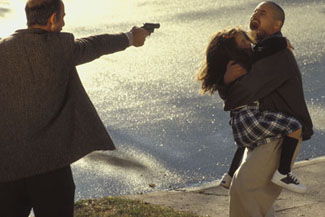Hollywood Psych
Summer Counter-Programming
By Sean Collier
July 10, 2009
This past weekend, the Michael Mann-helmed gangster film Public Enemies opened against such competition as animated powerhouse Ice Age: Dawn of the Dinosaurs and the still-reigning juggernaut of Summer 2009, Transfomers: Revenge of the Fallen. Both of the latter films had weekends around $42 million, with the autobot flick carrying a slight lead. Public Enemies, meanwhile, managed a thoroughly respectable $25.2 million and a total just above $40 million through the five-day July 4th weekend.
A third-place finish for a film starring two of the biggest summer draws of the last decade may seem like something of an underachievement. Indeed, this is most likely not quite the result that Universal was hoping for; however, as John Hamann pointed out in this weekend's wrap-up, this is an objective success. Period pieces are very tough to market and even tougher to open, and while many have gone on to earn the "sleeper hit" title, expecting a fedoras-and-tommy guns drama to make a huge splash in the middle of the summer is asking a lot.
Public Enemies is a rarity for the warmer months – a film aimed squarely and purely at adults. While younger viewers may react to Johnny Depp (and to a much lesser extent, Christian Bale,) this one wasn't marketed like anything but an action-filled drama for grown-ups. Such offerings are more traditionally the stuff of winter, as the Oscar rush pushes forward and kids head back to school; hard horror and nuanced period pieces are not at home amongst robots, explosions, and animated animals.
Mann's film, then, is an odd example of successful counter-programming. If the competition is Ice Age (families,) Transformers (kids, teens, and the poor of taste,) The Proposal (young couples,) and The Hangover (late teens/college kids,) then Universal was serving the only untouched demographic in the form of adult viewers. What makes this fairly unique, however, is that counter-programming doesn't often work like this.
Genre diversity is the traditional goal of providing box office competition. High-profile action release? Put out a romantic comedy. Family-friendly tentpole release? Roll out a horror sequel. Comedy juggernaut? Throwaway thriller. Usually, this works all right, particularly on films that weren't going to break box office records anyway; the opposing release scores a respectable opening and an ultimately profitable run.
What Public Enemies suggests, however, is that in the summer, playing to age might be the better bet. Transformers and Ice Age are, technically speaking, opposing genres: family and action. However, because it's the summer, and families are going together to anything rated PG-13 or lighter, they became direct competition, and Transformers kept Ice Age out of the top spot it would've had on many other weekends. Public Enemies, meanwhile – which might never have scored a number one finish – pulls off one of the most successful openings for a period piece in recent memory, simply by being the choice for adults. Last weekend saw a starker example of this – after debuting to an acceptable $20 ,illion, Year One was demolished by Transformers, dropping about 70% in its second weekend. Again, opposing genres – action and comedy – but because the same general demographic was targeted, Year One was destroyed.
There are a number of good examples of this playing-to-age tactic in the past few summers. Last year, The Happening opened to an utterly bewildering $30.8 million, in spite of the fact that the buzz on the film was universally abysmal and it was thoroughly unclear what the film was actually about (spoiler alert: freakin' plants. And wind. Plants and wind. Nice horror movie, there.) Nevertheless, this was a movie for the older set, and the advertising actually focused on this more than anything; commercials and posters highly touted The Happening as M. Night Shayamalan's first R-rated film. At the time, it was tough to figure out why that was the focus of the marketing; however, it clearly worked against competition from hopeful blockbuster The Incredible Hulk and the second weekend of Kung Fu Panda.
The best model, however, is 2005 Best Picture winner Crash. Clearly an awards-season contender, the film was inexplicably released semi-wide on May 6th. Its first weekend was nothing to write home about, as it pulled in $9.1 million for a fourth place finish, behind Kingdom of Heaven, House of Wax, and the second weekend of The Hitchhiker's Guide to the Galaxy. It held strongly, however. A slight 22.9% drop followed against three openers; another tiny 21% drop came the next weekend against the dominating $108.4 million opening of Revenge of the Sith. Crash was the only film in the top ten that weekend with a budget under $40 million dollars (only $6.5 million.) Despite looking absolutely nothing like a summer release in the traditional sense, it remained in the top 15 for nine weeks, pulling in over $50 million. Without a major winter re-release, it gathered enough buzz and acclaim to upset Academy Award favorite Brokeback Mountain for an unlikely win.
This is not a model that could work without fail; ultimately, some films will just got lost in the midst of the summer gargantuans. However, while traditional notions of counter-programming may work throughout most of the calendar, the success of Public Enemies and its older-skewing ilk may indicate that demographic appeal may be the key to lining up a studio's summer schedule. If nothing else, some of us are of legal age and would prefer not to see robots smash into things from June to August.




